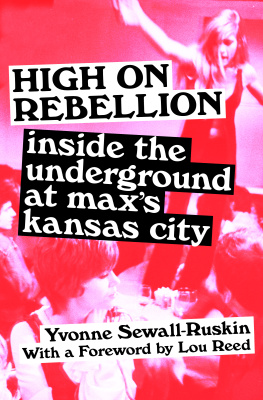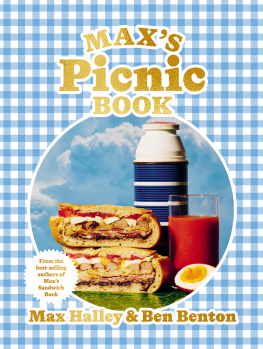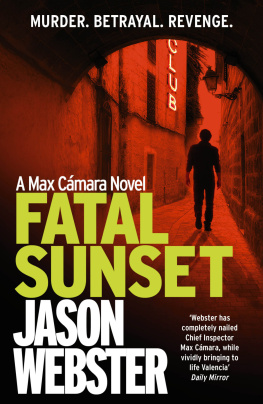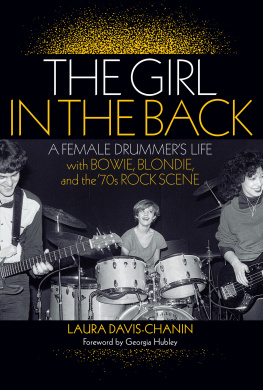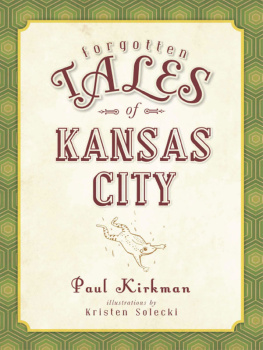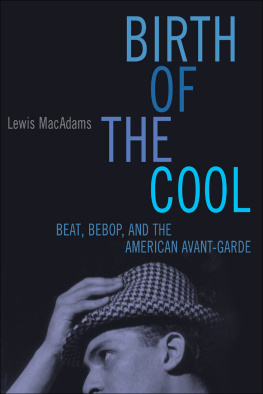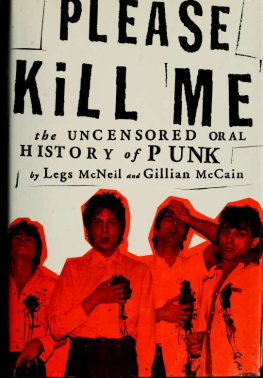High on Rebellion
Inside the Underground at Maxs Kansas City
Yvonne Sewall-Ruskin

Underground Melting Pot
My places have always been my living room and every night I throw a party. But at Maxs it went from being just an ordinary little salon and turned into Magic!
Mickey Ruskin,
owner and proprietor, Maxs Kansas City
Everyone who was anyone was there. Maxs Kansas City was the place to be. It quickly became the new drug of the late sixties and early seventies counterculture scene and its effects were lasting. The legendary restaurant/bar opened its doors in December of 1965 at 213 Park Avenue South, between Seventeenth and Eighteenth Streets off Union Square, just as popular culture was poised on the brink of a remarkable shift. The mere mention of Maxs conjures up images of chic and outrageousness. There never was a place like it and there never will be again.
The key to the energy of Maxs was the explosive chemistry among the participants. A veritable whos who of the famous and infamous adorned the place: Mick Jagger, Jane Fonda, Peter Fonda, Roger Vadim, Faye Dunaway, Bruce Springsteen, Allen Ginsberg, Jim Morrison, Lou Reed, Betsey Johnson, Bobby Neuwirth, Timothy Leary, Dennis Hopper, Abbie Hoffman, Patti Smith and Robert Mapplethorpe are a sampling. Debbie Harry or Emmylou Harris may have served your dinner before each got her big break. The quality of the mix led to such meetings as Andy Warhol and Valerie Solanas; Candy Darling and Divine; Abbie Hoffman and Janis Joplin; Robert Smithson and Tuesday Weld; and David Bowie, Iggy Pop and Lou Reed. David Bowie remembers: Me, Iggy, and Lou Reed at one table with absolutely nothing to say to each other, just looking at each others makeup. Where else but at Maxs could you find the brilliant feminist Germaine Greer wondering who had surreptitiously unsnapped her bra while at another table transvestite Jackie Curtis shared makeup tips with Kennedy family member Sargent Shriven Or the elegantly dressed Duke and Duchess of Windsor decked out in their couturier duds perusing menus within earshot of leather-jacketed Patti Smith and Sam Shepard, Maxs couple of the month. Up front, artist Robert Smithson might be sitting in a booth with Brice Marden, Dorothea Rockburne, and Carl Andre arguing over his theories of conceptual art, too intent to notice Cary Grant and his party, sitting in a booth across the way.
Maxs Kansas City was the nexus of underground culture where anything could happen, and did. People from all walks of life became addicted to the scene. To enter Maxs was to confront a heady mix of faces and personalities. To enter the notorious back room was an act of bravery. It was the longest-running party in history and the home away from home for an influential group of artists, filmmakers, musicians, writers, poets, photographers, models, movie stars, and socialites. Young people clamored to get into the joint. The raucous mix led to revolution in every facet of the arts. The action was always shifting and intense. In many ways Maxs exemplified instant gratification: drugs, sex, music, exhibitionism and voyeurismwhich is not to say that Maxs was lacking in intelligent conversation. Everything and everyone became homogenized in the extraordinary, psychedelic, multimedia atmosphere. Journalist Dick Nusser described it as a coming together of generations whose time had come. It brought the twenties, thirties, forties, and fifties into the sixties, and was the one place where anyone felt safe to let their hair down. Perhaps Jimi Hendrix said it best: Maxs Kansas City was where you could let your freak flag fly.
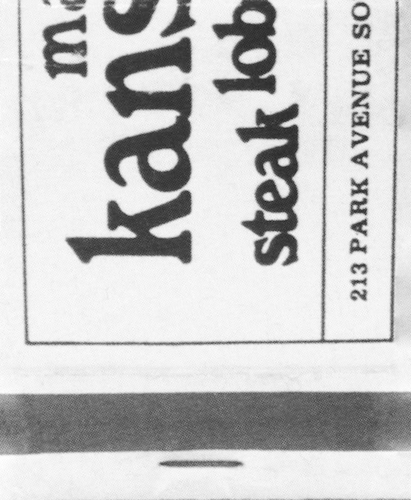
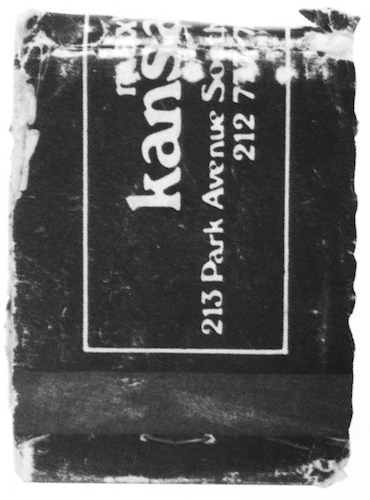
Maxs owed its incredible success to the late Mickey Ruskin, its owner and founder. The name Mickey Ruskin is synonymous with Maxs. Mickey was happiest in the company of painters and sculptors; his freewheeling attitude and generosity nurtured the budding careers of now-renowned abstract expressionists including Robert Rauschenberg, Larry Rivers, Brice Marden, Sol Lewitt, and Carl Andre, and Pop Art Superstars like Roy Lichtenstein and Andy Warhol. Ruskin gained his loyal following with a string of artist-oriented bistros, previously having owned the Tenth Street Coffeehouse, Cafe Deux Megots, the Ninth Circle, and the Annex. Mickey Ruskin nurtured the development of the New York underground scene from before the beginning. But Maxs Kansas City was his crowning achievement.
His transformation from nice, straitlaced Jewish boy with a Cornell law degree into ultra-hip restaurateur and unofficial rabbi of the demimonde, mirrored the transformation of so many others on the cutting edge of this provocative period who fled safe, middle-class backgrounds, pushing hard at the boundaries in search of adventure, artistic and otherwise.
Mickey Ruskin provided a libertine atmosphere in which the unconventional could flourish. Drugs and sex were definitely a major part of the mix at Maxs. In the years before the Stonewall Rebellion, Maxs was one of the few places of its kind where drag queens were accepted and, notwithstanding some good-natured ribbing from the macho artists at the bar, gay and straight reveled in each others company. Blurred sexual identity and sexual preferences contributed to the charged atmosphere. Beautiful young people exhibiting their flesh in black leather and miniskirts fueled the fire. Speed, LSD, pot, downs, heroin, and of course alcohol, all in plentiful supply, removed inhibitions. Photographer Derek Callender recalls, There were enough drugs in the back room to cause genetic defects.
Showtime, a nightly back-room event, often involved a striptease by Warhol Superstar Andrea Warhola Whips Feldman that was part performance art and part drug-induced psychosis. Danny Fields said, Its no cover, no minimum, for the greatest show in town. As far as Mickey was concerned, If I liked somebody, they had an absolute right to do whatever they wanted. And they wanted a lot. Enter the ladies or mens room and you might catch a glimpse of blond-haired, blue-eyed Eric Emerson (awarded the prize for the most sexual encounters) getting it on, or getting it up, with Jane Fonda, while her husband Roger Vadim watched. The age of consent in the back room was the age at which one could say yes. After all, this was the sixties and Maxs was the place where you could not only confront the values of the next generationyou could go to bed with them.
William Burroughs said, Maxs Kansas City was at the intersection of everything. And what a crowded intersection it was! It was also the wildest party that ever raged. The nightly events at Maxs Kansas City have permeated nearly every aspect of modern life, from the way we dress and behave, to our notions of freedom and liberty. Many of todays biggest stars and creative talents had the best times of their lives at Maxs. It was where they came of age. Rock icons like Jim Morrison, Alice Cooper, and David Bowie got an eyeful at Maxs and then translated it for their mass audiences. Punk was born at Maxs. Both Abbie Hoffman and Jerry Rubin used the crowd at Maxs as a sounding board for ideas. Politicians and socialites rubbed elbows with radicals and hustlers. Uptown met downtown.

